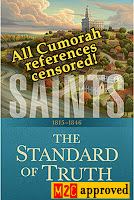Months ago I wrote a series of posts about the Early Modern English theory in which I observed the intersection between M2C and revisionist Church history. This post updates one of those posts.
As we saw in the Saints book, Church historians seek to accommodate M2C by actually changing Church history. Readers of Saints have no idea that Joseph Smith’s closest associates all accepted the fact, established in Letter VII, that the Hill Cumorah of Mormon 6:6 is in western New York.
The beauty of censorship is that readers have no idea what is missing.
The youth of the Church will never learn what the prophets have taught about the New York Cumorah. Nor will the millions of people who join the Church in coming years. That part of history will simply not exist for them. That ignorance allows the M2C hoax to thrive.
We saw how the editors of Saints tried to justify their censorship. They posted an explanatory FAQ right on lds.org. You can read about it here:
https://saintsreview.blogspot.com/2018/10/the-historians-explain-censorship-in.html
Surely, in their minds, these historians thought were doing the right thing when they imposed modern ideas about Book of Mormon geography onto Joseph’s contemporaries.
But it’s still phony history. And the historians know it.
It is astonishing that historians would deliberately change Church history to accommodate the M2C hoax.
But what is more astonishing is how many other ways the historians are changing Church history to accommodate M2C.
It is important to clarify that nothing in this post claims prophetic or Church support for any particular theory of Book of Mormon geography. Instead, it is exactly the opposite; i.e., this post seeks to support what the prophets have taught.
_____
 |
| BYU’s infamous fantasy map of the Book of Mormon that teaches students the prophets are wrong |
_____
Naturally, critics of the Book of Mormon have always sought to discredit its divine authenticity. They say it is fictional because Joseph (and/or others) wrote it and/or copied it from one or more sources.
Faithful LDS refute those claims with semantic arguments. They write blogs, post comments on Facebook and other social media, read and write books and articles, etc., all focusing on semantics, word choice, statistical analysis, etc.
KEY POINT: The intellectual debate over the divine authenticity of the Book of Mormon is essentially an exercise in confirmation bias. There is “evidence” to support whatever you want to believe.
Most participants in these discussions forget this key point. Their own confirmation bias blinds them to others’ perspectives. Anyone who wants to understand the issues thoroughly should be able to at least articulate contrary positions, using the facts and arguments of the various proponents.
Lawyers learn this in their first year at law school, but anyone who analytically observes the world realizes that those with whom we disagree are not merely ignorant or stupid. Everyone has different biochemistry and brain structure, different family and religious and social backgrounds, all of which (and more) lead to different biases we seek to confirm.
That said, I think it’s possible to break through confirmation bias if we heed the words of the prophets and the scriptures. That’s why we have prophets, after all.
In my view, these prophetic sources explain the evidence in such a way as to corroborate what Joseph Smith and Oliver Cowdery said all along.
This is why it is so destructive to have M2C intellectuals teaching the world (including LDS youth) that the prophets are wrong about the New York Cumorah–and all the other things I listed above.
_____
Source: Book of Mormon Wars

